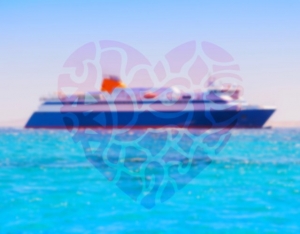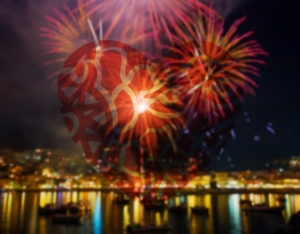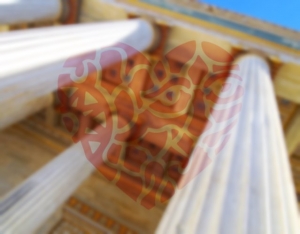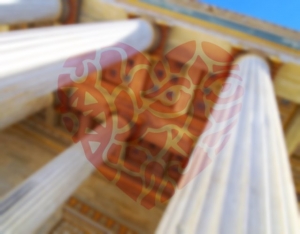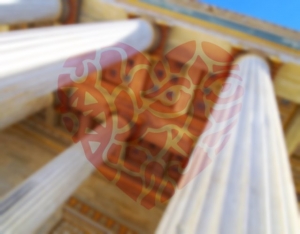Thodoris Bgenopoulos
You can reach Naxos by ship from the ports of Piraeus, Rafina and Lavrio or by island hopping from any other island in the Cyclades.
Apeiranthos is almost in the center of Naxos island.
Apeiranthos is built at an altitude of 600 meters, in the mountain Fanari, and it is 28 km from the main town--Chora. The residents of Apeiranthos (which also call it «t 'Aperathou) are considered to be mostly of Cretan origin.
Apeiranthos is a traditional stone-built village with Venetian towers, two-storey houses and beautiful squares. Wander through the picturesque alleys, discover the hidden beauties and do not forget to visit the many interesting museums available. The Archaeological Museum of Apeiranthos Folklore Museum of Apeiranthos, the Apeiranthos Geological Museum and the Natural History Museum of Apeiranthos will impress you.
Apeiranthos stands out from other villages of the island, due to its special customs and the particular idiom. Apeiranthos is a must-see during your holidays in Naxos.
Naxos is mentioned in Greek mythology as the place where Theseus, returning from Crete after slaying the Minotaur, abandoned Ariadne. According to myth, the abandoned Ariadne was detected by the god Dionysus, who fell in love with her and took her to Olympus.
Naxos was inhabited already from the 4th millennium BC and played an important role in the Cycladic civilization, which is proved by the important archaeological findings that can be seen in the Archaeological Museum of Naxos and the archaeological sites on the island.
During the classical period, the construction of the temple of Apollo begun and today you can only see the remaining famous Portara. In 490 BC Naxos was destroyed by the Persians and it later joined the Athenian League. When it collapsed, it also lead Naxos in decline.
During the Byzantine times, Naxos belonged to the Aegean Theme, while in 1207 it was occupied by the Venetians and Marco Sanudo established the Duchy of Naxos. The island was governed by the Venetians until the mid-16th century, when Turks occupied it and created impressive castles and towers.
Naxos remained under Ottoman rule until the Greek Revolution of 1821, when together with the other islands in the Cyclades it finally became part of the newly established Greek state.
Naxos is the largest island in the Cyclades, with an area exceeding 430 square kilometers. The length of its shores is almost 91 km and a big part of it shapes fantastic beaches. The highest point of the island is Zeus, at an altitude of about a thousand meters.
Arriving in Naxos by ship (yes the island also has an airport) the first thing you will notice is the trademark of the island, the famous Portara. As you get off from the ship, you will be in Chora, the capital and largest settlement on the island.
You will surely spend much of your time here to see for yourself all the sights in town. Indicatively, there is the Castle of Chora, the Archaeological Museum of Naxos, the Naxos Venetian Museum, the Byzantine Museum of Naxos and Epitope Museum.
Leaving Chora to explore the rest of the beautiful island, it is worth visiting the Temple of Demetra, the Temple of Dionysus and of course the impressive marble Kouros that are scattered around Naxos. Do not forget to pass by Apeiranthos, a beautiful picturesque village with many interesting museums and the Bazeos Tower, which hosts several cultural events.
Of course Naxos has great tourist infrastructure. Here you will find excellent hotels and guest rooms, traditional taverns and, magnificent restaurants, charming bars, cafes and clubs and everything else you might need to spend your holidays wonderfully.
Holidays in Naxos will be unforgettable.
Patmos. This is a relatively small island in the Dodecanese, not exceeding 35 square kilometers. Rocky and barren, Patmos island actually began to develop after 1088 when the Monastery of Saint John the Theologian was founded. The Monastery and the Cave of the Apocalypse, where St John the Theologian wrote the Revelation, one of the 27 books of the New Testament, turned Patmos into a significant spiritual center.
Today Patmos, the holy island of the Dodecanese, is a cosmopolitan tourist destination that still maintains its intense spirituality.
When you reach Patmos, the first thing you'll face is Skala, which is the island's port. Here you'll find whatever you expect from a prime tourist destination: restaurants, taverns, bars, hotels and guest rooms, as well as transport for the rest places and the beautiful beaches of the island.
The most prominent place in Patmos that attracts thousands of visitors every year is, without doubt, Chora. It is a beautiful traditional village, above which one of the two main attractions of the island, the Monastery of St. John the Theologian dominates . The second is of course the Cave of the Apocalypse, which is located on a hill between Skala and Chora. You need not be a faithful Christian to understand the magnetism exuded by these locations.
Stroll around the picturesque narrow alleys of Chora, discover wonderful houses, stately mansions and windmills and enjoy the wonderful view before heading out to explore the rest of the island and its beautiful beaches.
Patmos is a very special tourist destination that rewards its visitors with much more than the ordinary. You could be one of them...!
August 15th is undoubtedly the largest celebration in Tinos. In mid-August two major events coincide: the celebration of the Assumption and the anniversary of the torpedoing of "Elli".
Thousands of believers literally flood the island to see or worship the miraculous icon of the Virgin. Throughout the years, numerous people have found hope in this Sacred icon and most of them come to Tinos under a vow. Some go up to the church on their knees to worship (this is why you'll notice a red rug "climbing" the central road to the Church), while others await the procession of the icon to pass under it and get Her blessing.
On the celebration day, Greek warships, contingents, political and religious leaders arrive in Tinos and honor the miraculous icon. Music bands accompany the procession of the icon with marches, while speeches take place and wreaths are deposited.
Along with the celebration of the Assumption, the memory of the tragic crew of the destroyer ship "Elli" is honored. It may have been cowardly hit and sunk by an Italian submarine in the port of Tinos on August 15, 1940, but it was never forgotten in Tinos and all over Greece. Every year, the leader of the Greek Navy leaves a wreath into the sea, right were "Elli" ship was, while at the same time the church bells and the cannon shootings (by the ship's cannon rescued from the wreck) create a hauntingly beautiful atmosphere.
August 15th in Tinos is a very special day worth experiencing that combined with holidays, will stay in your heart forever.
Tinos is an island known for its religious nature and surviving traditions. Those who visit it have a chance to experience this first hand.
It goes without saying that Easter in Tinos is a unique, heart-felt and spiritual experience, either you are a Believer or not. Each part of the island decorates its epitaph with great care and the procession is accompanied by chanting and absolute devotion. In many parts of Tinos, like Chora for example, the epitaph enters the sea in memory of all the sailors who lost their lives in the raging waves. The Resurrection with the fireworks and the Easter table complete a once in a lifetime experience that one should definitely live, by choosing Tinos island for Easter holidays.
Adding to that, several festivals and celebrations are organized in Tinos, including:
- July 23, feast of Agia Pelagia in Kechrovouni Monastery that is accompanied by the transfer of icon of Virgin Mary from Panagia of Tinos to the monastery and then back to the church of Panagia, accompanied by a faithful crowd.
- August 15, feast of Panagia/ Our Lady of Tinos that takes place in many other areas of the island
- August 23, feast of Kyra Kseni in the Pyrgos village
- September 6, feast of Agios Sostis in the namesake area
Tsoklis Museum is in Kampos, one of the finest villages of Tinos.
The main purpose of the museum is to host the work of Costas Tsoklis. On the premises of the museum apart from the works of the renowned artist you can also see his file, interviews and articles about him, photos and TV and radio broadcasts. What's more, the Tsoklis museum organizes creative workshops, programs and theatrical performances in Koumaros theater.
If you find yourself in Tinos, Tsoklis museum is definitely one of the must-dos!
More information concerning the Tsoklis Museum can be found in www.tsoklismuseum.gr and the number 22830 51009.
Museum of Panormos Artists - Giannoulis Chalepas' Museum in Tinos
02 May 2015
Lovers of sculpture behold! You can visit the Museum of Panormos Artists and Giannoulis Chalepas' Museum in Pyrgos village, in Tinos. The two buildings are located within walking distance from each other and together form a small "temple" dedicated to sculpture.
The ancestral home of the famous sculptor Giannoulis Halepas is now turned into a museum. Here you can see personal items, photographs, furniture, utensils, the area where he created when he was in Tinos, as well as several works.
In the Museum of Panormos Artists you can admire sculptures and engravings by notable artists such as Filippotis, Sochos, Lampaditis and many others who were inspired by Tinos. It is no lie that this is a very special island...
More information about the Museum of Panormos Artists and Giannoulis Chalepas' Museum can be found in the number 22830 31 262.
The Museum of Marble Crafts is in Pyrgos village, in Tinos.
Established in 2007, this is the most modern museum in the island. Here you have the chance to see the whole course of marble, from mining to obtaining its final form by the hands of the sculptor.
In the museum, visitors can admire among others:
- Tools for quarrying and marble crafts
- Works in marble for daily use (fountains, lintels, coats etc)
- Models and plaster copies
- Mechanical equipment (lifting machine, marble wagons etc.)
The Museum of Marble Crafts has placed particular emphasis on familiarizing children with marble carving. So it has a number of excellent films to teach children (and parents) the history and technique of processing marble and occasionally organizes activities and games on marble carving.
From the moment you set foot on Tinos, an island that hides a marble masterpiece in every corner, it would be silly of you not to visit the Museum of Marble Crafts and learn the secrets of the art of marble.
More information about the Museum of Marble Crafts in Tinos can be found in the number 22830 31293.

